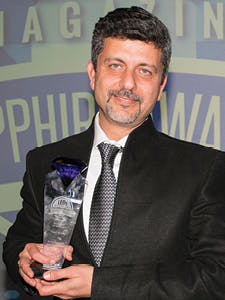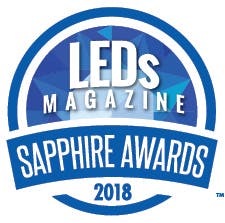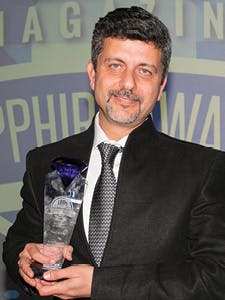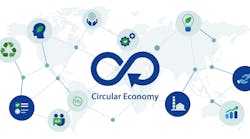MAURY WRIGHT interviews TANUJ MOHAN of Enlighted after Mohan was named the LEDs Magazine Sapphire Awards Illumineer of the Year for his work on using sensors to understand a building’s environment and the actions of occupants.
On February 14, 2017 in Long Beach, CA, LEDs Magazine announced the winners in the 2018 Sapphire Awards program at a Gala aboard the RMS Queen Mary that took place coincident with Strategies in Light. The Gala culminated with the announcement of the Sapphire Illumineer of the Year — Tanuj Mohan, co-founder and CTO of Enlighted. We subsequently talked with Mohan about his strategic vision and how it has been brought to commercialization at Enlighted. Tanuj describes a value proposition focused on understanding how a building is used by the occupants and deploying systems that make more efficient use of expensive commercial real estate. LED lighting proves to be a perfect enabler for such a mission.
LEDs Magazine: Hi, Tanuj. It’s been a decade for you since founding Enlighted. Can you rewind back to the start and tell us a little about the early days? That was a time when it was not an accepted “sure thing” that LED sources would become mainstream in general lighting. Was lighting always central to your vision? Were you focused on buildings and the Internet of Things (IoT) at first without necessarily planning to rely on a solid-state lighting (SSL) backbone? What was the vision at the start and how has it evolved?
Tanuj Mohan: It was literally two guys and a garage — well, actually a private office that we had subleased from another startup. We kept the doors closed, as we had wires exposed and open fixtures in the ceiling. We were running on inspiration and blissfully ignoring building codes and safety concerns. We’ve always been about intelligent sensors, and the coming LED revolution seemed like the perfect vehicle to deliver power and position for the sensors. The smart sensors would provide value by making the spaces highly energy efficient and completely flexible for occupant satisfaction.
Along our journey, we received some very good advice. The two pieces that come to mind are first, never ask a customer to make multiple leaps of faith. LEDs and a new control system from an inexperienced team in the lighting industry is too much change for a customer to accept. Second, small startups can’t wait for waves of innovation when the current market bears the cost of a less efficient technology. Fluorescents were magnitudes cheaper than LEDs. Realizing this, we quickly discovered that a wireless sensor systemthat could be added to an existing fluorescent or LED fixture as easily as a bulb or ballast replacement was the solution. It worked with all existing light fixtures, did not need a new ecosystem to support power over Ethernet (PoE) lighting, and worked for both retrofit and new construction. When all of these challenges resolved simultaneously, we knew we had the solution right. Today, the SSL revolution is real and is accelerating the deployment of Building IoT platforms.
Our initial vision was around optimizing the building for all-around energy efficiency, space planning, and fire and life safety applications. Today, we realize that we can improve the business outcomes for our customers by providing indoor location services and insights based on machine learning from all the data we gather.
LEDs: You clearly had success working in the IT-centric networking industry prior to Enlighted. How did you come upon the idea to apply that knowledge to buildings and SSL?
Mohan: Most of my prior life in the IT industry was spent sitting in a cube-farm optimizing performance, improving manageability, and increasing reliability of networking gear. On many occasions, I would find myself alone in my cubicle with an entire floor lit up just for me. The sheer waste always bothered me. I knew that huge amounts of energy and money were being wasted. The actual founding of Enlighted was kind of by accident. I was working on two ideas with a former colleague who was involved in what he called a “PoE- like” lighting solution. When I looked at the solution, my first instinct was, “Why is it only ‘PoE-like’? What prevents it from being PoE?” If the lighting solution is a networking system, it was in the realm of problems I could solve optimally.
Efficient lighting, I realized, looked more and more like a networking and network management problem that I had solved many times before. So, translating lighting systems to network systems was the easy part! The tough part was understanding the constraints of building technology and the slow rate of change. In technology, we can stand to reboot our computers or install upgrades on a regular basis. But what if you had to reboot your AC or wait while your new lighting control programs downloaded? When the technology impacts your physical environment, you tend to not mess with it. What you lose when you embrace stability like this is the chance for making improvements, and when the current state is suboptimal, such as the lights in that office I started in, this means you’re stuck throwing away money as wasted energy.
LEDs:Looking at Enlighted from the outside, the company appeared more focused on being a wireless networking company at first glance. Learning more about the business and some early case studies, it becomes apparent that sensor architecture is probably the core competency of the company. Is that an accurate characterization? How would you characterize your value proposition?
Mohan: While I appreciate you looking into our early days, that wasn’t truly the goal of Enlighted early on. We didn’t have a single wireless or RF engineer in the company, and our first-generation sensor had three different communication mechanisms — wireless, power-line communication, and IP/Ethernet. We were focused on building a learning platform not just at the sensor endpoint but also for the network backhaul. The only problems we heard with existing lighting control solutions were that users had to wave their hands. Our flexible, though costly, initial solution taught us about installation and commissioning challenges while putting in place a learning system with rich data feeds for understanding and optimizing occupant needs. The architecture of the entire solution was built to learn and grow.
LEDs: We often think of sensors as low-cost devices with very simple interfaces. Yet your technology relies on relatively complex sensors with integrated processing capabilities. How did that vision evolve and why does such an architecture make sense?
Mohan: Coming from the IT world, we always knew our sensors would run out of processing horsepower and memory as more features were added — and with user experience as part of our solution, we would be adding new features rapidly. We never buy a computer with just enough screen, memory, and processing power for the few apps we use — but buy the best we can so we have headroom for future applications. Sure, we might not need all that memory and we might never use it, but we’d rather be ready to embrace the latest changes even if we know the industry is growing so rapidly that our newest technology will be obsolete in a few years. The tolerance toward risk in our case is high, but it is also expected. The building technology world was all about costs and code. Building managers are always asking how can we meet the basic lighting requirements with minimum cost. For me, this mindset was not enabling; it was like buying a computer with exactly as much memory and processing power as you were currently using, and expecting your needs in the future wouldn’t increase, closing yourself off to new and amazing technology that could help you work better because it was too costly. What buildings were doing wasn’t efficient anyway; it wasn’t sustainable. Installed lights and sensors are part of buildings for 10 or more years, so what you install on day one needs to have the capabilities to collect that data and expand into the future — or no new insights can ever be learned.
LEDs:Also on the sensor subject, it seems your strategy has been to develop sensors that really are multi-sensors integrated with processing into an intelligent subsystem. That would not seem to be the most economical approach at first because some applications might only need occupancy sensing or another only daylight sensing. Why integrate so many different sensor types in one subsystem?
Mohan: Again, the thinking was not for occupancy-based lighting only but to understand the building environment and, more importantly, what the occupants are doing. Where the savings and value happens is when you have this long-term, high-resolution data, and those things you assume about how people use the space become quantified. Then you can act on them. Regarding the light sensor, it’s one of the most useful components of our system. The light sensor was never just for daylight harvesting — that is, using the ambient light in a space to manage the supplied lighting — but it can provide a wealth of information about the environment by looking at how it changes over time and space, and it can also be used as a communication channel. For example, in the future it might detect fires before an emergency call could be placed. We don’t subscribe to the idea of using each sensor on our platform independently; by design we are a multi-channel digital sensor capable of being remotely programmed to meet the current and future needs of the platform.
LEDs: Is the cost of the integrated processor the factor that drives the multi-sensor approach?
Mohan: Actually, the cost of the processor is not significant — the multi-sensor approach was always for future proofing. Combining and analyzing data streams at the end node allowed us to expand the usefulness of the platform well beyond lighting.
LEDs: Having talked to some of your partners in the luminaire manufacturing industry, they seem content to supply sensors that have far more functionality than might be used at first with new luminaires. The strategy centers on the end customer deciding to add new software services or applications to run on the lighting network post-installation. But we haven’t seen many case studies that prove out that strategy. Do you see that strategy as viable and can you offer any examples?
Mohan: Enlighted has identified several high-value applications in various verticals and has started deploying them with leading-edge customers. Today in high rent areas, the average office space per person has shrunk from 250 ft2 (2003) to 151 ft2 (2017). Our workplaces are becoming activity based. The data and insights an Enlighted system provides helps companies to optimize expensive commercial real estate while improving employee productivity. Conference room management, desk hoteling, wayfinding, and space optimization are some of the use cases enabled by our system.
Hospitals have been looking for a cost-effective, reliable, secure, and accurate RTLS (real-time location services) solution for over a decade. The use cases from nurse equipment finding, patient wayfinding, patient call-button compliance, infant abduction prevention, pre- and post-operative room readiness, etc. are orders of magnitude more valuable than the energy or the real estate. We are now working with hospitals to drive these applications as the new norm for modern hospitals.
We are absolutely convinced that in the next 2–3 years sensors deployed with luminaires will be the new platform for deploying IoT applications in real estate.
LEDs:We avoided asking about the wireless network that you use up front, but that discussion is a popular one any time the lighting industry gathers. There are many standard and proprietary approaches to networking, and the SSL industry is not moving toward ubiquity very quickly. We would consider your approach proprietary, although you aren’t the only company to use the same baseline technology. How did you approach that decision? Has Enlighted relied on the same networking technology all along?
Mohan:Open standards are the best options in most situations because they enable more information to be shared amongst systems and more comprehensive solutions to be discovered. I say most situations because in our case, none of the open standards fit our application well enough to be a reasonable solution. Today, we use the IEEE802.15.4-based chips (same as ZigBee, Thread, etc.) but had to run them in a proprietary mode with our network stack to get the security posture we wanted, and backhaul data with high throughput. We also engineered it to be less “chatty” to maximize data traffic versus control or health traffic. Lighting control does not require this amount of data, but we were using this same network to track thousands of objects in a building in real time.
As mentioned, our solution isn’t about each component of our sensor as separate pieces of technology; it’s about creating an intelligent platform, and so the standard needs to embrace the requirements of a multi-dimensional sensor. The industry isn’t there yet. We’ve created a standard out of necessity, so that we can say, “Here is the standard we need to run an Enlighted system” — and that sets the bar for other technologies to evolve toward our standard as the next generation of smart lighting platforms.
LEDs: How would you expect the networking situation to evolve? Arguably, your applications could run on any network and your sensors could easily be revised to support other networks.
Mohan: We started the company being network agnostic, just looking for the right solution that met our price, performance, and security needs. Not finding any, we built our network stack on existing off-the-shelf standard hardware. As Moore’s law holds true and IoT network solutions evolve, we are on the constant lookout for off-the-shelf open standard networks that meet our needs.
Both networking and Enlighted will evolve, and we are thinking future-forward about what we will do as more sensor platforms and networks are available, but fundamentally we will always first think about making sure whatever network solution we have, it is based on the goal of delivering comprehensive solutions for our customers.
LEDs:Of all the smart-building applications we hear about — space optimization, indoor wayfinding, asset tracking, and many more — is there one application that excites you the most beyond efficient buildings?
Mohan: Indoor location — or bringing the “where” in buildings — is what is really exciting. We’ve been spending a lot of time perfecting that technology recently, really dog-fooding it in our office. Our employees and some of our equipment wear tags willingly to indicate their locations. If I go looking for our CEO based on his location on the screen and find him within a few feet, it’s pretty impressive, and very efficient. Now he’s an easy target as he’s a tall guy, but imagine looking for something smaller and more discreet — medical equipment, laptops, or prescriptions — or using indoor location to find a specific resource amongst many similar items like warehousing or retail, and you see how this technology could change lives.
LEDs: Congratulations on winning our Sapphire Illumineer of the Year award. You were up against some very tough competition. Can you describe what you were feeling coming into the Gala back in February? What does the award mean for you? And how did the Enlighted team respond to the award?
Mohan: Even before the awards were announced, I felt like a winner to have my name alongside a Nobel Prize winner among the other distinguished nominees. I’m honored that my contributions are worthy of being named Illumineer of the Year. When we received the award, I received about 20 excited emails from my colleagues within five minutes, but then everyone went back to work so we can continue focusing on being the company we all dreamed we could be. I still receive a handful of emails weekly from partners and customers congratulating me.








